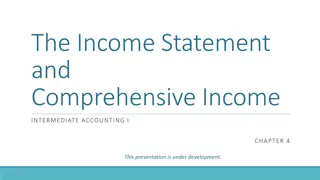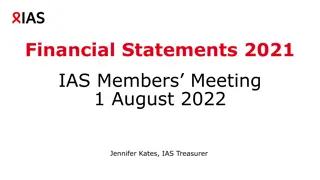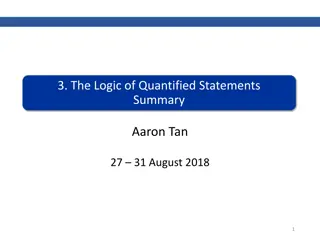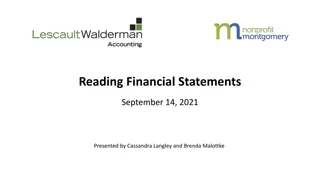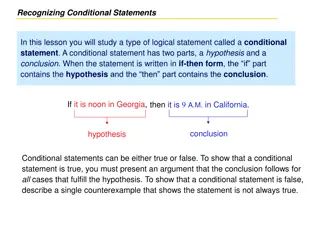
Financial Statements for Business Analysis
Explore the meaning of financial statements, including Income Statement and Balance Sheet, essential for understanding a business's financial health and performance over time. Learn how these statements help analyze revenue, expenses, assets, and liabilities, providing a snapshot of the financial position at a specific moment. Gain insights into interpreting financial data for informed decision-making.
Download Presentation

Please find below an Image/Link to download the presentation.
The content on the website is provided AS IS for your information and personal use only. It may not be sold, licensed, or shared on other websites without obtaining consent from the author. If you encounter any issues during the download, it is possible that the publisher has removed the file from their server.
You are allowed to download the files provided on this website for personal or commercial use, subject to the condition that they are used lawfully. All files are the property of their respective owners.
The content on the website is provided AS IS for your information and personal use only. It may not be sold, licensed, or shared on other websites without obtaining consent from the author.
E N D
Presentation Transcript
ANALYSING FINANCIAL STATEMENTS Presented by Dr. B. N. Shinde Assistant Professor Department of Commerce Deogiri College, Aurangabad
ANALYSING FINANCIAL STATEMENTS MEANING OF FINANCIAL STATEMENTS A financial statement is an organized collection of data according to logical and consistent accounting procedures. Its purpose is to convey an understanding of some financial aspects of a business firm. It may show a position at a moment of time as in the case of a balance sheet, or may reveal a series of activities over a given period of time, as in the case of an Income Statement.
Continue Thus, the term 'financial statements' generally refers to two basic statements: (i) the Income Statement and (ii) the Balance Sheet. A business may also prepare (iii) a Statement of Retained Earnings, and (iv) a Statement of Changes in Financial Position in addition to the above two statements.
Financial Statements 1. Income Statement 2. Balance Sheet 3. Statement of Retained Earnings 4. Statement of Changes in Financial Position
1. Income Statement The Income statement (also termed as Profit and Loss Account) considered to be the most useful of all financial statements. It explains what has happened to a business as a result of operations between two balance sheet dates. For this purpose it matches the revenues and costs incurred in the process of earning revenues and shows the net profit earned or loss suffered during a particular period. is generally
Continue The nature of the 'Income' which is the focus of the Income Statement can be well understood if a business is taken as an organization that uses 'inputs' to 'produce' output. The outputs are the goods and services that the business provides to its customers. The values of these outputs are the amounts paid by the customers for them. These amounts are called 'revenues' in accounting. The inputs are the economic resources used by the business in providing these goods and services. These are termed as 'expenses' in accounting.
2. Balance Sheet It is a statement of financial position of a business at a specified moment of time. It represents all assets owned by the business at a particular moment of time and the claims of the owners at outsiders against those assets at that time. It is in a way a snapshot of the financial condition of the business at that time.
Continue The important distinction between an income statement and a Balance Sheet is that the Income Statement is for a period while Balance Sheet is on a particular date. Income Statement is, therefore, a flow report, as contrasted with the Balance Sheet which is a static report. However both are complementary to each other
3. Statement of Retained Earnings The term retained earnings means the accumulated excess of earnings over losses and dividends. The balance shown by the Income Statement is transferred to the Balance Sheet through this statement, after making necessary appropriations. It is thus a connecting link between the Balance Sheet and the Income Statement. It is fundamentally a display of things that have caused the beginning of the period retained earnings balance to be changed into the one shown in the end- of the period balance sheet. The statement is also termed as Profit and Loss Appropriation Account in case of companies.
4. Statement of Changes in Financial Position (SCFP) The Balance condition of the business at a particular moment of time while the Income Statement discloses the results of operations of business over a period of time. However, for a better understanding of the affairs of the business, it is essential to identify the movement of working capital or cash in and out of the business. This information is available in the statement of changes in financial position of the business. The statement may emphasize any of the following aspects relating to change in financial position of the business: Sheet shows the financial
Continue i. Change in working capital position. In such a case the statement is termed as SCFP (Working Capital basis) or popularly Statement. ii. Change in cash position. In such a case the statement is termed as SCFP (Cash basis) or popularly Cash Flow Statement. Funds Flow
Continue iii. Change in overall financial position. In such a case the statement is termed simply as Statement of Changes in Financial Position (SCFP).
ANALYSIS AND INTERPRETATION OF FINANCIAL STATEMENTS Financial significant factors: Statements are indicators of the two i. Profitability, and ii. Financial soundness Analysis and interpretation of financial statements, therefore, refers to such a treatment of the information contained in the Income Statement and the Balance Sheet so as to afford full diagnosis of the profitability and financial soundness of the business. .
A distinction here can be made between the two terms - 'Analysis' and interpretation . The term' Analysis' means methodical classification of the data given in the financial statements. The figures given in the financial statements will not help one unless they are put in a simplified form. For example, all items relating to 'Current It Assets' are put at one place while all items relating to 'Current Liabilities' are put at another place. The term 'Interpretation' means explaining the meaning and significance of the data so simplified. However, both' Analysis' and 'Interpretation' are complementary to each other.
Continue Interpretation requires Analysis, while Analysis is useless without Interpretation. Most of the authors have used the term' Analysis' only to cover the meanings of both analysis and interpretation, since analysis involves interpretation.
Continue According to Myres, "Financial statement analysis is largely a study of the relationship among the various financial factors in a business as disclosed by a single set of statements and a study of the trend of these factors as shown in a series of statements." For the sake of convenience, we have also used the term 'Financial Statement Analysis' throughout the chapter to cover both analysis and interpretation. '








